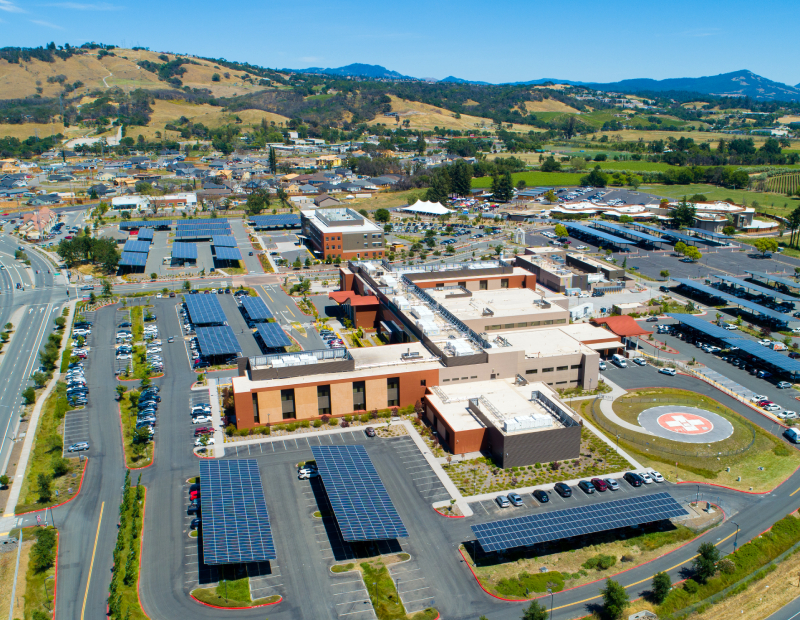Solar Installations Power Through the Pandemic
Projects at commercial properties have continued apace, fueled by pre-COVID approvals, cost-reduction goals and opportunities to install systems while buildings are largely unoccupied.

Sutter Health Santa Rosa Hospital. Image courtesy of Ameresco
Though COVID-19 has halted many facets of contemporary life, the installation of solar energy systems at commercial properties doesn’t appear to be among them.
Despite inevitable delays, commercial properties have mostly continued the installation of solar photovoltaic systems, according to solar industry experts. Bob Georgeoff, vice president of Framingham, Mass.-based renewable energy solutions provider Ameresco, said the pandemic hasn’t significantly slowed his company’s solar PV projects. “Renewable energy continues to be a priority for building owners and occupants,” he noted.
That same prioritization, in many cases fueled by the renewable energy’s bottom-line benefits, has been noted by Atlanta-based Tom Warren, co-leader of law firm Eversheds Sutherland’s Energy Projects Team. His team has seen some projects delayed as stakeholders eyed capital expenditures. “But because solar is increasingly economical, people are exploring it as a way of saving money,” he added.
On the other side of the nation, Phoenix-based Direct Solar of America has forged progress on commercial property customers’ solar projects. Among recent efforts is a 535KW project for the city of Parlier, Calif.; a 630KW project for AET Realty in Park Ridge, Ill.; and a 5.5MW project at Sunflower Solar Farm in Joshua Tree, Calif.
Direct Solar founder Pablo Diaz reports his company is active in 30 states. In 90 percent of them, its work is considered an essential business. “There might be an issue finding an inspector as quickly (as pre-pandemic),” he said. “But generally speaking, work goes on. And right now, our phones are starting to ring again.”
PwC U.S. power and utilities leader Casey Herman in Chicago also believes that gaining building inspections—along with zoning approval—is more vexing during COVID-19. But otherwise, he hasn’t witnessed greater hurdles in building commercial property solar installations than tackling any other construction.
Residential vs. Commercial
Through the pandemic’s course, commercial projects have faced fewer headwinds than their residential counterparts. One big reason is that the crisis emptied commercial spaces while simultaneously filling residential settings with sheltering people, Herman said. Moreover, many commercial projects had gained pre-pandemic approvals.
Warren attributes lower residential market activity to many Americans’ need to conserve finances. “But I see . . . even an upsurge in the commercial area,” he said. “A lot of the commercial projects are small, and can generally get financing for this year. As projects are scheduled further out, some into 2021, it’s harder.”
In some cases, work-from-home orders by employers have quickened the pace of commercial property solar construction projects. Ameresco is working on one of the nation’s largest solar carport installations at a huge commercial campus. “Since there are no cars in the parking lots, we are taking advantage of this to accelerate our schedules,” Georgeoff said. “On the development side, some manufacturing customers see no major change in operations, and have now more than ever a need for resilient, renewable and cost-reducing systems to meet their energy needs.”
As for pandemic-sparked impact on costs related to labor and materials, “We haven’t seen it yet,” Diaz said. “Maybe we will later.” Warren has learned of installers demanding price increases during ongoing negotiations. Herman heard of converter, circuit board and PV panel availability impacted by import restrictions. “But I’ve not had a client tell me they’re not able to get what they need.”
Large-Scale Projects
By virtually all accounts, large-scale projects don’t appear to have been halted by the pandemic. “A lot of my clients are building utility-scale solar and wind projects,” Herman said. “The contractors building them have so far not delayed their construction. But many of them have notified their customers they consider this a force majeure issue, given the pandemic.”
Georgeoff believes given both the crisis and its impact on operating budgets, goals of energy resiliency through distributed energy generation via solar and battery energy storage have become more top-of-mind than ever before.
While most commercial solar installation projects continue to work, some have encountered substantial delays. Marina Vaamonde, founder of PropertyCashin, planned with partners to install solar panel upgrades in company-owned Houston-area medical facilities. The project was to begin in March, but the contractor informed Vaamonde it would be delayed as late as November.
The Chinese panel-making factory had been shuttered four months and was now reopening at 25 percent capacity. “Knowing the solar tax credits are set to expire in 2022, I don’t know if we’ll still be able to complete new installs or retrofit at all our properties due to major disruptions in the supply chain,” she said, adding that she anticipates supply shortages sparking equipment price hikes.







You must be logged in to post a comment.